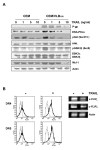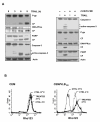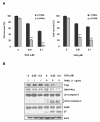TRAIL sensitize MDR cells to MDR-related drugs by down-regulation of P-glycoprotein through inhibition of DNA-PKcs/Akt/GSK-3beta pathway and activation of caspases
- PMID: 20663232
- PMCID: PMC2918570
- DOI: 10.1186/1476-4598-9-199
TRAIL sensitize MDR cells to MDR-related drugs by down-regulation of P-glycoprotein through inhibition of DNA-PKcs/Akt/GSK-3beta pathway and activation of caspases
Abstract
Background: The development of new modulator possessing high efficacy, low toxicity and high selectivity is a pivotal approach to overcome P-glycoprotein (P-gp) mediated multidrug resistance (MDR) in cancer treatment. In this study, we suggest a new molecular mechanism that TRAIL (tumor necrosis factor-related apoptosis-inducing ligand) down-regulates P-glycoprotein (P-gp) through inhibition of DNA-PKcs/Akt/GSK-3beta pathway and activation of caspases and thereby sensitize MDR cells to MDR-related drugs.
Results: MDR variants, CEM/VLB10-2, CEM/VLB55-8 and CEM/VLB100 cells, with gradually increased levels of P-gp derived from human lymphoblastic leukemia CEM cells, were gradually more susceptible to TRAIL-induced apoptosis and cytotoxicity than parental CEM cells. The P-gp level of MDR variants was positively correlated with the levels of DNA-PKcs, pAkt, pGSK-3beta and c-Myc as well as DR5 and negatively correlated with the level of c-FLIPs. Hypersensitivity of CEM/VLB100 cells to TRAIL was accompanied by the activation of mitochondrial apoptotic pathway as well as the activation of initiator caspases. In addition, TRAIL-induced down-regulation of DNA-PKcs/Akt/GSK-3beta pathway and c-FLIP and up-regulation of cell surface expression of death receptors were associated with the increased susceptibility to TRAIL of MDR cells. Moreover, TRAIL inhibited P-gp efflux function via caspase-3-dependent degradation of P-gp as well as DNA-PKcs and subsequently sensitized MDR cells to MDR-related drugs such as vinblastine and doxorubicin. We also found that suppression of DNA-PKcs by siRNA enhanced the susceptibility of MDR cells to vincristine as well as TRAIL via down-regulation of c-FLIP and P-gp expression and up-regulation of DR5.
Conclusion: This study showed for the first time that the MDR variant of CEM cells was hypersensitive to TRAIL due to up-regulation of DR5 and concomitant down-regulation of c-FLIP, and degradation of P-gp and DNA-PKcs by activation of caspase-3 might be important determinants of TRAIL-induced sensitization of MDR cells to MDR-related drugs. Therefore, combination of TRAIL and chemotherapeutic drugs may be a good strategy for treatment of cancer with multidrug resistance.
Figures








Similar articles
-
[Molecular mechanism of cisplatin to enhance the ability of TRAIL in reversing multidrug resistance in gastric cancer cells].Zhonghua Zhong Liu Za Zhi. 2015 Jun;37(6):404-11. Zhonghua Zhong Liu Za Zhi. 2015. PMID: 26463141 Chinese.
-
P-glycoprotein enhances TRAIL-triggered apoptosis in multidrug resistant cancer cells by interacting with the death receptor DR5.Biochem Pharmacol. 2006 Jul 28;72(3):293-307. doi: 10.1016/j.bcp.2006.04.024. Epub 2006 May 4. Biochem Pharmacol. 2006. PMID: 16753135
-
Galectin-3 silencing inhibits epirubicin-induced ATP binding cassette transporters and activates the mitochondrial apoptosis pathway via β-catenin/GSK-3β modulation in colorectal carcinoma.PLoS One. 2013 Nov 26;8(11):e82478. doi: 10.1371/journal.pone.0082478. eCollection 2013. PLoS One. 2013. PMID: 24303084 Free PMC article.
-
Down-regulation of intracellular anti-apoptotic proteins, particularly c-FLIP by therapeutic agents; the novel view to overcome resistance to TRAIL.J Cell Physiol. 2018 Oct;233(10):6470-6485. doi: 10.1002/jcp.26585. Epub 2018 May 9. J Cell Physiol. 2018. PMID: 29741767 Review.
-
Molecular targeting therapy of cancer: drug resistance, apoptosis and survival signal.Cancer Sci. 2003 Jan;94(1):15-21. doi: 10.1111/j.1349-7006.2003.tb01345.x. Cancer Sci. 2003. PMID: 12708468 Free PMC article. Review.
Cited by
-
CD133 and DNA-PK regulate MDR1 via the PI3K- or Akt-NF-κB pathway in multidrug-resistant glioblastoma cells in vitro.Oncogene. 2016 Jan 14;35(2):241-50. doi: 10.1038/onc.2015.78. Epub 2015 Mar 30. Oncogene. 2016. Retraction in: Oncogene. 2016 Oct 20;35(42):5576. doi: 10.1038/onc.2016.64. PMID: 25823028 Retracted.
-
miR-199a-5p Represses Protective Autophagy and Overcomes Chemoresistance by Directly Targeting DRAM1 in Acute Myeloid Leukemia.J Oncol. 2019 Sep 15;2019:5613417. doi: 10.1155/2019/5613417. eCollection 2019. J Oncol. 2019. PMID: 31636666 Free PMC article.
-
Identification and Validation of a Prognostic Risk-Scoring Model Based on Ferroptosis-Associated Cluster in Acute Myeloid Leukemia.Front Cell Dev Biol. 2022 Jan 21;9:800267. doi: 10.3389/fcell.2021.800267. eCollection 2021. Front Cell Dev Biol. 2022. PMID: 35127715 Free PMC article.
-
FL118, a novel camptothecin analogue, overcomes irinotecan and topotecan resistance in human tumor xenograft models.Am J Transl Res. 2015 Oct 15;7(10):1765-81. eCollection 2015. Am J Transl Res. 2015. PMID: 26692923 Free PMC article.
-
Sensitization of multidrug-resistant human cancer cells to Hsp90 inhibitors by down-regulation of SIRT1.Oncotarget. 2015 Nov 3;6(34):36202-18. doi: 10.18632/oncotarget.5343. Oncotarget. 2015. PMID: 26416354 Free PMC article.
References
Publication types
MeSH terms
Substances
LinkOut - more resources
Full Text Sources
Molecular Biology Databases
Research Materials
Miscellaneous

